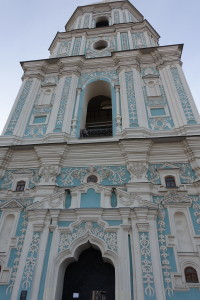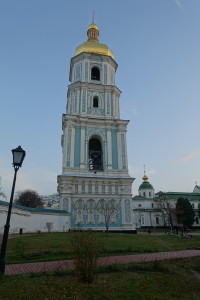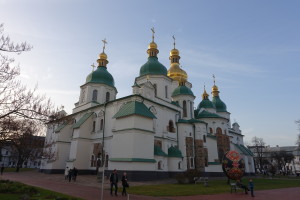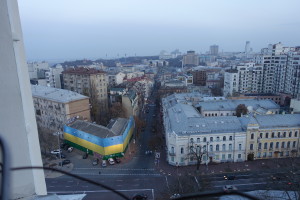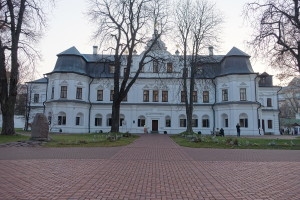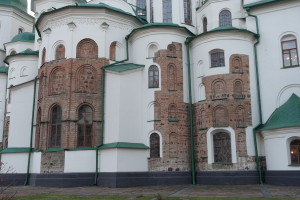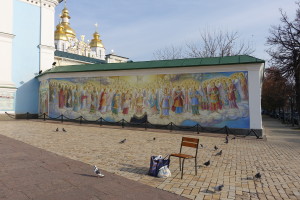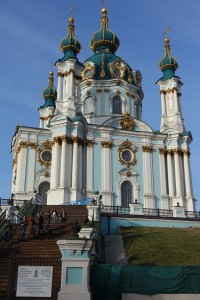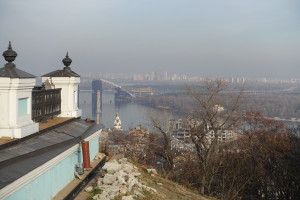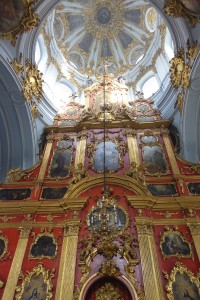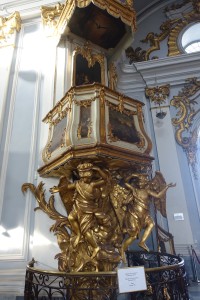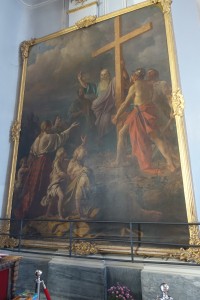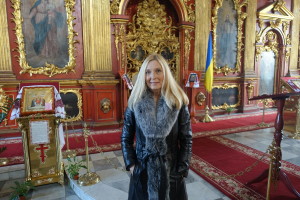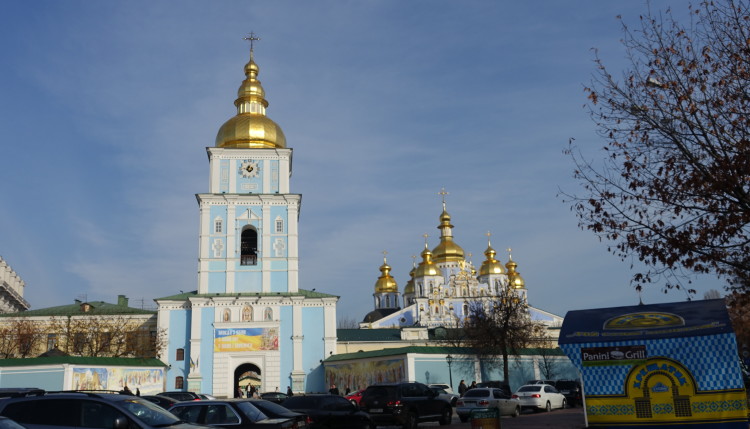
Holy Places in Kyiv
Saint Sophia’s Cathedral: As one looks towards this cathedral it’s outward beauty is clearly visible but its real beauty lay hidden in its scars. If walls could talk, these hold a novel filled with stories.
I struggle to find words adequate enough to describe both the outward beauty of Saint Sophia’s Cathedral and the spiritual “centeredness” I felt while inside it. Standing atop its bell towers evoked a broad range of emotions as I looked across the city. While walking through the buildings, adequate descriptions elude me; pictures tell more; standing here in person I felt tingly inside. I’m really here! Sadly, taking photos inside the cathedral are not allowed. Thus, I am left with a few lonely pictures taken on the outside of the buildings and cathedral plus, those from atop the Bell Tower. I can still feel the excitement just “remembering.”
Though I wanted to climb the tower just to feel the “bell’s large presence inside the tower facing all the stairways was a bit daunting. I paused several times to let others pass who were either climbing up or down the stairs faster than I.
Reaching the top level was rewarded with these amazing views.
Climbing down from the tower might be easier, but staring down each step reminded me of my tumble down the flight of black granite stairs in a London hotel only a few short weeks prior! I held tight to the railing and took my tim. Once outside into the courtyard we passed the abbey and other numerous buildings that comprised Saint Sophia monastery.
This is oldest cathedral (built in 1037 by Prince Yaroslav the Wise himself) with 13 domes, and a bell tower added in the mid 1700’s. It is the largest Eastern Orthodox Cathedral in Eastern Europe. Designed to rival Hagia Sophia in Constantinople (Istanbul), Prince Yaroslav the Wise built this in honor of his great grandmother, Princess Olga. (It replaced a destroyed church that was named after Princess Olga.
The Princess, considered a saint by the Orthodox faith, and equal to the original Disciples of Christ, is one of only 5 women considered in that regard. Due to her faith in Christ, her grandson, Vladamir the Great, turned the country’s paganism to Christianity–the national religion. Olga’s decision to worship Jesus (including her burial as in the Christian manner) led to Prince Vladimir’s construction of the Lavra, and brought laws, libraries, and culture to Kievan Rus.
Inside the cathedral and the museum my eyes tried to absorb almost a thousand years of Kyivan, Ukrainian and the ancient ‘Kyivan Rus’ history. Life, told through each meticulous brushstroke of original artwork; with the intricately composed mosaics–tiny fragments of colored glass and ceramic tiles placed onto the walls and floors inside; and in the enormous frescoes painted upon every available surface inside the church. As I gazed into the faces of each saint, royal figure or angel it seemed as if they stared right back at me. Every space of the cathedral (including the floors) told a story.
Did I really understand the importance of each, or the history within the walls of this monastery? I’m certain it was not nearly enough. Still, each room seemed to speak to me, invading my thoughts as I began this journey through Kyiv.
Saint Sophia: a burial place for the kings; a museum of “what was”; an art gallery; and a place of worship–all wrapped into one stunning example of Ukrainian byzantine architecture. But it’s always been more than that. This past year Saint Sophia (as other churches in the city) played an integral part in the healing of the land upon which it rests. Just as a thread ties one piece of cloth to another, this cathedral holds together much of Ukrainian, Eastern European, and Russian history. After almost a thousand years, it still stands as a testament to the spiritual strength of this country.
God our Father weaves our personal histories, using Jesus Christ as the thread. I feel His hands as he “pulls me together” with a gentle tug here and a pull or push there. He adds this time and this particular place into the tapestry of my life–sixty years of “me”. While I ponder each of these wondrous cathedrals, I am spiritually aware of the many prayers for thanksgiving, praise, the petitions and pleadings before God’s throne. Only God sees the finished product. He’s not finished with the Ukraine just as I’m still a work in progress. Though I often feel tattered and torn, Jesus alone fills the gaps, heals the broken pieces and provides my hope for the future.
Philippine 1:6, “And I am certain that God, who began the good work within you, will continue his work until it is finally finished on the day when Christ Jesus returns.”
I trust in Him. He led me here–to Kyiv and to this cathedral. His presence is easily seen and felt. While looking down from the Bell Tower, another beautiful cathedral is seen only a short distance away, in a direct path from the entrance of Saint Sophia. It is Saint Michael’s Monastery.
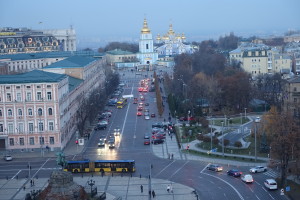
Saint Michael’s Cathedral in a straight path from Saint Sophia’s–the golden domes shine even on a cloudy day.
Saint Michael’s Monastery:
This monastery’s history contains both glorious and disastrous events. Built during the early 1100s, Saint Michael’s Golden Domed Monastery commemorated victory over nomadic tribes and honored the archangel Michael–considered the patron saint/angel of the Kyevan Rus warriors.
Right after people fled through the doors of the original monastery (attempting to escape Tatar and Mongol invaders), the first domes (actually gilded in gold), suffered their first destruction in the 1200s. Built, destroyed, then rebuilt again.
Numerous restorations and enlargements led to its loss of historical significance. The U.S.S.R. (under Stalin in the 1930s) decided to demolish this beautiful structure just to build government offices on this site. Quickly, before totally destroyed, Ukrainians strived to remove the historic treasures inside. Though a few mosaics were relocated, most of the artifacts, treasures and gold were stolen by either Socialist Russia (pre WWII), by Hitler (Germany) or later, by the Communist Soviet Union. Not until Ukraine achieved independence in 1991 did this Monastery begin its restoration–most of the work completed in 1999 with the reopening of its doors in 2000.
Just recently the church bells rang out in a manner similar to the bell sounds alerting people (800 years ago) at the first sign of attacks by enemies. In early December 2013, the church bells rang out to summon reinforcements when violence first broke out in Kyiv. As President Viktor Yanukovich turned his back on a deal with the European Union, Saint Michael’s emerged once again as the spiritual protector and sanctuary for the Ukrainians desiring freedom from Russian “control” and oppression of the Ukraine.
Ukrainian Orthodox priests vehemently spoke out on behalf of the protestors–even going so far as to “stand between” police and protestors. An action protecting Ukrainians against the violence of police (ordered by Yanukovich and Putin) as officers fired bullets and lethal hand-made smoke bombs into the crowds.
Beautiful Saint Michael’s Monastery transformed itself into a “hospital” for Kiev’s injured during those early months of turmoil, 2014.
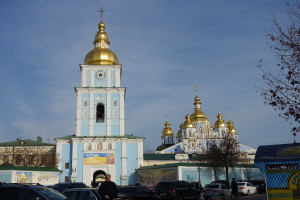
Saint Michael’s Monastery opened its gate to the wounded citizens–a great comfort in times of grief.
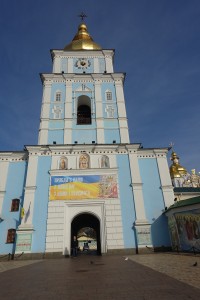
A Bell Tower of strength during the Ukrainian Revolution of 2014–bells clanged loudly numerous times during this battle for freedom.
The wounded and sick found refuge and healing here. President Yankovich prohibited traditional hospitals from admitting or even administering aid to “protestors.” This monastery took matters “into its own hands” by becoming a hospital in which doctors and nurses came to the aid of those wounded during the months of siege and revolution. Heroically performing surgeries, sewing up gaping wounds and ministering to those in need, ordinary Ukrainians performed extraordinary acts by unselfishly bringing their own food, bandages, and medicines to help to their fellow countrymen. (If this sounds like a page in a history book about life a few hundred years ago, it is not. It happened right here only a few months ago.)
Art covers the exterior walls of the monastery. People looked to God in times of trouble. Saints painted on this wall remind those who pass–all are welcome here.
A church built on the site of Saint Andrew’s vision for this Christian nation. Saint Andrew’s Church: Honoring Jesus own disciple Andrew–sent into the world to proclaim the Gospel of Christ arrived in Kyiv.
It is claimed that Saint Andrew journeyed from the Black Sea through the Dnieper River during the first century AD to rest upon the hillside of Kyiv and erect a cross on the site of this church. He prophesied that the sparsely inhabited area would become a great city for God.
Just like the other Christian churches, numerous churches were erected and destroyed on this spot where Saint Andrew erected the first cross. First, a small wooden church was built by the Grand Prince of Kiev Vsevolod in 1086. The second, a bit larger one in 1215, was constructed by Prince Mstyslav of Halych. Mongol invaders (beginning in 1240) destroyed every church built thereafter. It was not until the Russian Princess Elizabeth decided to construct a summer palace in Kyiv, and a church here for herself, did construction on this cathedral occur. Once the Princess placed the first three stones in 1744 this particular church took shape. Like other churches in Ukraine, this one suffered repeat destructions and restorations during the 1900s.
Now, it still teeters upon a crumbling foundation, set upon an unstable hillside. Will this cathedral continue to stand? Its magnificent exterior and interior glorify God–just as the Apostle Andrew intended.
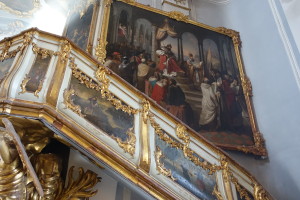
Paintings, carvings and architecture kept my mind focused on the God who inspired such beauty…my Lord and Savior, Jesus Christ.
So many questions: What changes will this church, this city, this country enjoy, overcome or perhaps, endure? Many of the original golden Icons and treasures were stolen over the years of destruction, but real treasures here are not in the “seen,” they are in the “unseen.”
In Matthew 6:19-21, we are warned, “Do not lay up for yourselves treasures on earth, where moth and rust destroy and where thieves break in and steal, but lay up for yourselves treasures in heaven, where neither moth nor rust destroys and where thieves do not break in and steal. For where your treasure is, there your heart will be also.”
No one destroyed the Ukrainian people. If Saint Andrew did indeed place a cross in this land by traveling up the Dnieper River and predict this land belonged to Jesus, he was not wrong. Tribes, Mongols, Turks, Tsars, Socialism, Hitler, Communism and the U.S.S.R. failed to destroy what God began here.
Psalm 46:1 reminds us we are to “look to God as our refuge and strength; a very present help in trouble.”
As Ukraine history reveals, trouble does indeed come. God does not look away, He is there in the midst of it. God is my strength and refuge. He is my help during troubling times and will remain as a refuge, a strength and helper when trouble comes to Ukraine. His presence is everywhere.
